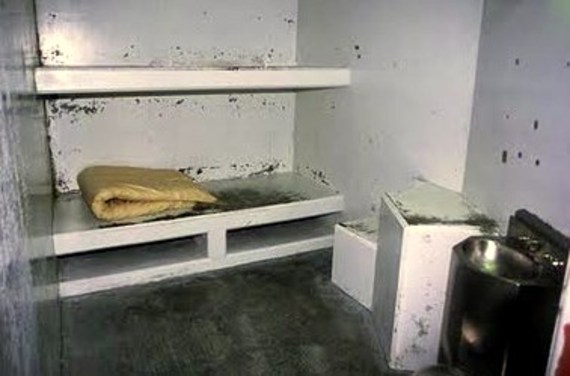Every year more than 300,000 people are arrested in New York City and roughly 100,000 people cycle through the city jail system at a cost to the taxpayer of $167,731 per incarcerated person per year. Most people held on Rikers Island and other borough specific facilities -- 75 percent -- are awaiting the disposition of their cases and are, thus by law, innocent.
The most common charges are misdemeanors like trespassing, criminal mischief, possessing stolen property and drug offenses. More than 90 percent of people held on Rikers Island are either Black or Latino. About 40 percent of the 12,200 people imprisoned on Rikers Island on any given day have some type of mental health diagnoses, with about one-third of those managing complex mental health issues such as schizophrenia and bipolar disorder that jails are ill-equipped to support. Despite their perceived and protected innocence, people held in city jails are forced to live under deplorable conditions, amidst tremendous violence, with little access to medical or mental health care, or to programming that might promote positive pro-social development. Forensic social workers can often identify which of their clients have previously spent time incarcerated, even for a short period of time, based on behavioral traits that people develop inside as defense mechanisms. The Jails Action Coalition has reported that four New Yorkers have died on Rikers Island during the past three months alone, as a result of abuse, neglect, ineffective protections and the psychological impact of imprisonment. It should be uncontroversial to state that every human being deserves to be treated with dignity and respect no matter their circumstances, particularly those members of our society that are the most vulnerable.
A recent NYC Board of Corrections (BOC) meeting disclosed a troubling state of affairs at the city jails. Reform goals for 2013 were not met and BOC members openly questioned the capacity of the Department of Corrections to implement policy changes. Violence between prisoners, guards and medical staff is on the rise and the department's use of solitary confinement and punitive segregation remain sticky subjects as the deleterious effects of isolation have become better known to the Board following an active year of lobbying by jail advocacy groups. The Jails Action Coalition was credited for pushing the Board to engage in reforms through the group's legislative efforts to revise the minimum standards to which the BOC rule-making is required to comply. Collective bargaining agreements between the Department of Corrections and their officers were cited at the meeting as a complicating factor in enacting changes.
Recently, the number of incidents where corrections staff used force against people held in the jails has risen sharply. Use of force incidents have tripled between 2004 and 2013 to now include nearly one-quarter of all prisoners, according to a recent report by the Associated Press. So too have reports of violence between people held in the jails. Health logs at Rikers Island indicate that between 2010 and 2012 there were nearly 6,000 traumatic injuries sustained by people detained in city jails, approximately 1,000 of which required a hospital visit. Rapes, gang violence and assaults occur frequently. There is a large discrepancy between the incident numbers reported by the Mayor's Management Office and the Department of Corrections and the jails' medical logs. The DOC reported approximately 50 stabbings and slashings in each of 2011 and 2012, although hospital reports covering the same period listed 1,000 serious laceration injuries. Prisoners' rights groups and the correction officers' union both claim that the city is intentionally downplaying the violence. The Department of Corrections chalked up the gap to falls and work-related injuries. Last summer, the Department of Corrections came under fire after a leaked surveillance tape showed guards declining to intervene in a jail-house brawl as dozens of young men beat each other with chairs, mops and table-legs.
Many have linked the increased violence at Rikers Island to the increased usage of solitary confinement, which often leaves people with lasting physical and psychological damages. The sensory deprivation of solitary confinement, which is used in city jails to punish all types of infractions, has been shown to lead to severe depression, anxiety, hallucinations, paranoia, insomnia and panic attacks, leaving those subjected to it prone to unstable and potentially violent behaviors making them more likely to break rules, regulations and be arrested in the future, according to the advocacy group Solitary Watch.
A 2013 Associated Press article noted that one person incarcerated at Rikers Island had logged nearly 3,000 days in the mental health punitive segregation units. Many of the assaults on staff and suicides on Rikers Island take place in these units. New York City has one of the highest usage rates for solitary confinement in the country, doubling the national average, and people find themselves confined there for assaults, but also minor infractions like not following orders or testing positive for drugs. Until last year, the Department of Corrections was converting regular cells to solitary "bing" rooms as fast as they could.
"We are building them whenever possible," DOC spokeswoman Sharman Stein told the Daily News in November 2011.
New legislation spearheaded by the grassroots coalition New York Campaign for Alternatives to Isolated Confinement, and recently introduced by state legislators, would virtually eliminate the use of solitary confinement in New York State jails and prisons.
The Department of Corrections supposedly shuttered its Mental Health Assessment Unit(s) for Infracted Inmates (MAUII) at the end of 2013, replacing them with a two-tiered punitive segregation system, but the Board of Corrections indicated this month that changes appeared to be "in name only." During their year-end visits to several of the newly rebranded Restrictive Housing Units (RHUs) on Rikers in 2013, Board of Corrections staff found that the facilities shared the same damaging conditions as the MAUIIs -- minimal to no programming, no day room activities, little to no consistent specially trained staff, no uniform procedures or rules between RHUs at different jails.
At George Motchan Detention Center (GMDC), one of the 10 jails on Rikers Island, people were denied access to reading materials, denied health care, locked down early, and even locked in the showers for a time, BOC member Dr. Robert L. Cohen reported. BOC members found cells covered in human feces and were required to intervene to save the life of a confined person who had tied a ligature around her neck and wedged herself under a bed. Corrections staff, according to BOC member Byranne Hammil, a former New York State Family Court Judge, refused to assist the woman and she only received medical care after Hammil called emergency medical staff personally. Cohen also reported being present during a suicide attempt while visiting the RHUs in the men's jails. In contrast, the new Clinical Alternative to Punitive Segregation (CAPS) program for mentally ill patients was in better shape, but running at less than half capacity, the board reported. Commissioner Dora Schriro said that many of the problems are the result of staffing shortages.
All of this depicts a general callousness toward people's human dignity that is endemic to every area of law enforcement and corrections in New York City. All winter long, people are released from corrections custody without jackets or appropriate attire into the frigid winter temperatures in New York City. In July of 2013, 37-year-old Kyam Livingston died in Brooklyn Central Bookings. After suffering through stomach pains and diarrhea for several hours, she begged officers to provide her with medical care and was met only with threats that complaining would result in longer confinement. Seven hours after she was brought in, the other female prisoners in her cell attempted to revive her as the officers finally called for an ambulance. The family has filed a civil law suit against the city, demanding changes to conditions inside the city jails. Just this month, Edward Soto, a 51-year-old man from the Bronx, died in a holding cell in an Upper East Side police precinct house. The cause of death remains unknown and the NYPD's Internal Affairs Bureau is investigating how officers monitoring him allowed him to die.
While the reforms intended by the Department of Corrections are admirable, especially their consideration of potentially eliminating the use of punitive segregation for juveniles, the pace of the proposed changes is too slow. No person deserves to be tortured, deserves to be driven to suicide by isolation, or to be denied medical care and mental health counseling. Most people in the city jails are there not because they have been convicted of a crime, but because they were unable to post bail -- they are our neighbors, our community members, our families. Kalief Browder was 16-years-old when he was arrested on a robbery charge after leaving a party in the Bronx. He spent the next three years at Rikers Island, more than 400 days in solitary confinement, attempted suicide six times and was assaulted and beaten both by officers and fellow residents. He was totally innocent of the crimes he was charged with and eventually the case was dismissed outright. His story could happen to anyone.
If we cannot provide humane treatment at our city jails then we cannot use these facilities until they are improved. If we cannot maintain the current capacity of our jails and treat people there with dignity and respect then we need to explore alternatives like bail reforms, fewer custodial arrests and other means to keep the number of people incarcerated low enough so that DOC can provide appropriate services. With an operating budget of more than $1 billion dollars a year, the Department of Corrections has a major impact on what other services can be provided throughout the city -- such as housing, employment, healthcare -- having a direct impact on public safety and community life. We need to be sure that the vast resources spent on punishment, particularly pretrial detention, are effective, humane and not doing greater harm to already marginalized or vulnerable communities in our city.

